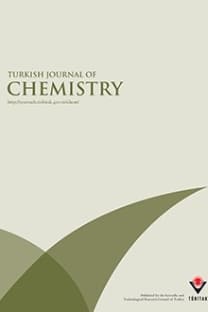Synthesis, Characterization, and Biocidal Studies of the Newly Synthesized Di- and Triorganotin(IV) Complexes with n-Butylhydrogen Phthalate
Organotin(IV) complexes, n-butylhydrogen phthalate, spectral characterization, biological activity
Synthesis, Characterization, and Biocidal Studies of the Newly Synthesized Di- and Triorganotin(IV) Complexes with n-Butylhydrogen Phthalate
Organotin(IV) complexes, n-butylhydrogen phthalate, spectral characterization, biological activity,
___
- P.J. Smith, “Chemistry of Tin”, 2nd Ed. Blackie Academics of Professionals, London (1998).
- L. Tian, Z. Zhon, B. Zhao, H. Sun, W. Yu and P. Yang, Synth. React. Inorg. Met.-Org. Chem. 30, 307 (2000).
- H.L. Sing, M.A. Sharma and K. Varshancy, Synth. React. Inorg. Met.-Org. Chem. 30, 445 (2000).
- K.C. Molly, “The Chemistry of Metal-Carbon Bond, Bio-organotin Compounds”, ed. F.R. Ha rtley, John Wiley, New York (1995).
- S. Shahzadi, M.H. Bhatti, K. Shahid, S. Ali, S.R. Tariq, M. Mazhar and K.M. Khan, Monatsh. Chem. 133, (2002).
- A. Ruzicka, L. Dostal, R. Jambor, V. Buchta, J. Brus, I. Cisarova and M. Holcapek, J. Appl. Organomet. Chem. 16, 315 (2002).
- S.J. Blunden, P.A. Cusaked and R. Hill, “The Industrial Uses of Tin Chemicals”, The Roya l Society of Chemistry, London (1985).
- C.J. Evans, “Chemitry of Tin”, ed. P.G. Ha rrison, Bla ckie, Gla sgow (1989).
- Z. Ahmad, H.U. Rehman, S. Ali and M. I. Sarwar, Int. J. Polym. Mater. 46, 547 (2000).
- Sadiq-ur-Rehman, S. Ali, M. Parvez, M. Mazhar and A. Badshah, Heteroatom Chem. 15, 398 (2004).
- Sadiq-ur-Rehman, S. Ali, A. Badshah, A. Malik, E. Ahmed, G.-X. Jin and E.R.T. Tiekink, Appl. Organomet. Chem. 18, 401 (2004).
- Sadiq-ur-Rehman, K. Shahid, S. Ali, M. Mazhar, A. Badshah, G. Eng, X. Song and J. Ryczkowski, Het- eroatom. Chem. 16, 175 (2005).
- Sadiq-ur-Rehman, K. Shahid, S. Ali, M.H. Bhatti and M. Parvez, J. Organomet. Chem. 690, 1396 (2005).
- K. Sisido, Y. Takeda and Z. Kingawa, J. Am. Chem. Soc. 83, 538 (1961).
- M. K. Leung and J. M. Frechet, J. Chem. Soc. Perkin Trans. 2, 2329 (1993).
- (a) W.L.F. Armarego and D.D. Perrin, “PuriŞcation of Laboratory Chemicals”, 5th ed. Perga mon, Oxford (1997). (b) W.L.F. Armarego and C.L.L. Chai, “PuriŞcation of Laboratory Chemicals”, 5th ed.
- Butterworth-Heinemann, London, New York (2003).
- G.B. Deacon and R. Phillips, J. Coord. Chem. Rev. 33, 227 (1980).
- M.H. Bhatti, S. Ali, H. Masood, M. Mazhar and S.I. Qureshi, Synth. React. Inorg. Met.-Org. Chem. 30, (2000).
- S. Ali, F. Ahmad, M. Mazhar, A. Munir and M.T. Masood, Synth. React. Inorg. Met.-Org. Chem. 32, (2002).
- D.H. Williams and I. Fleming, “Spectroscopic Methods in Organic Chemistry”, 4th ed. McGraw-Hill Book Company, Ltd., UK (1987).
- T.P. Lockhart, W.F. Manders and E.M. Holt, J. Am. Chem. Soc. 108, 6611 (1986).
- T.P. Lockhart and W. F. Manders, Inorg. Chem. 25, 892 (1986).
- M. Nadvornik, J. Holeˇcek, K. Handlir and A. Lycka, J. Organomet. Chem. 275, 43 (1984).
- F. Ahmed, S. Ali, M. Parvez, A. Munir, M. Mazhar and T.A. Shah, Heteroatom Chem. 13, 638 (2002).
- M. Danish, S. Ali, M. Mazhar, A. Badshah, M.I. Choudhary, H.G. Alt and G. Kehr, Polyhedron. 14, 3115 (1995).
- K. Shahid, S. Ali, S. Shahzadi, A. Badshah, K.M. Khan and G.M. Maharvi, Synth. React. Inorg. Met.-Org. Chem. 33, 1221 (2003).
- H.O. Kalinowski, S. Berger and S. Braun, Carbon NMR Spectroscopy, John Wiley: Chichester, UK (1988).
- A. Badshah, M. Danish, S. Ali, M. Mazhar, S. Mahmood and M.I. Choudhary, Synth. React. Inorg. Met.- Org. Chem. 24, 1155 (1994).
- M. Danish, S. Ali, A. Badshah, M. Mazhar, H. Masood, A. Malik and G. Kehr, Synth. React. Inorg. Met.-Org. Chem. 27, 863 (1997).
- M. Danish, H.G. Alt, A. Badshah, S. Ali, M. Mazhar and N. Islam, J. Organomet. Chem. 486, 51 (1995).
- B. Wrackmeyer, G. Kehr and J. Suss, Chem. Ber-Recl. 126, 2221 (1993).
- J. Holeˇcek and A. Lycka, Inorg. Chim. Acta. 118, L15-L16 (1986).
- M.A. Demertzis, S.K. Hadjikakou, D.K. Demertzi, A. Koutsodimou and M. Kubicka, Helv. Chim. Acta. 83, (2000).
- S.S. Shoukat, N.A. Khan and F. Ahmed, Pak. J. Bot. 12, 97 (1980).
- A. Rahman, M.I. Choudhary and W.J. Thomsen, Bioassay Techniques for Drug Development; Harward Academic Press: Amsterdam (2001).
- K.C. Molloy, Biorganotin Compounds. In the Chemistry of Metal-Carbon Bond; F.R. Hartley, (Ed.); Wiley: New York (1989).
- B.N. Meyer, N.R. Ferrigni, J.E. Putnam, L.B. Jacobson, D.E. Nichols and J.L. McLaughlin, Planta Med. 45, (1982).
- ISSN: 1300-0527
- Yayın Aralığı: 6
- Yayıncı: TÜBİTAK
Mevlut SERDAR, Nurhan GÜMRÜKÇÜOĞLU, Şengül ALPAY KARAOĞLU
Hamid Javaherian NAGHASH, Akram KARIMZADEH, Ahmad Reza MOMENI, Ahmad Reza MASSAH, Hamid ALIAN
Yasemin DÜNDAR, Bilge ÇAKIR, Esra KÜPELİ
Convergent Synthesis of Fluorinated Dendrons Using the Mesylate Activation Route
Özgür Altan BOZDEMİR, Meltem DİLEK, Mehmet TUTAŞ
Nevin KARABÖCEK, Serdar KARABÖCEK, Fatma KORMALI
Muhammad HANIF, Mukhtiar HUSSAIN, Saqib ALI, Moazzam H. BHATTI
A New Approach to Furan-Containing Macrolactones
Christoph Q. SCHMIDT, Ruth MESSMER, Franz BRACHER, Jürgen KRAUSS
New Diterpenoids from the Aerial Parts of Salvia pilifera
Pınar KARA, Kağan DAĞDEVİREN, Mehmet ÖZSÖZ
Synthesis and Antimicrobial Activities of Some New 1,2,4-Triazole Derivatives
